Astronomy 1101 --- Planets to Cosmos
Todd Thompson
Department of Astronomy
The Ohio State University
High-Mass Stars
- High-Mass Stars = O & B Stars (M > 4 Msun)
- Stars with 4 < M < 8 Msun
- Burn Hydrogen up through Carbon
- Blow off their envelope
- Core becomes an O-Ne-Mg White Dwarf
- Stars with M > 8 Msun
- Burn Hydrogen up through Carbon, Neon, Oxygen & Silicon
- Iron Core Formation & burning shells
- Catastrophic collapse of Iron Core.
High-Mass Stars
O & B Stars (M > 4 Msun):
- Burn Hot
- Live Fast
- Die Young
Main Sequence Phase:
- Burn H to He in core via CNO cycle
- Build up a He core, like low-mass stars
- Last for only ~ 10 Myr
Red Supergiant Phase
After H core exhaustion:
- Inert He core contracts & heats up
- H burning in a shell around the contracting He core
- Huge, puffy envelope ~ size of orbit of Jupiter
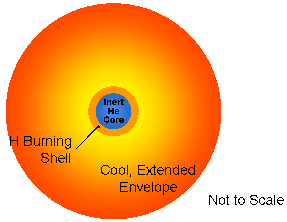
(Graphic by R. Pogge)
Moves horizontally across the H-R diagram, becoming a
Red Supergiant star
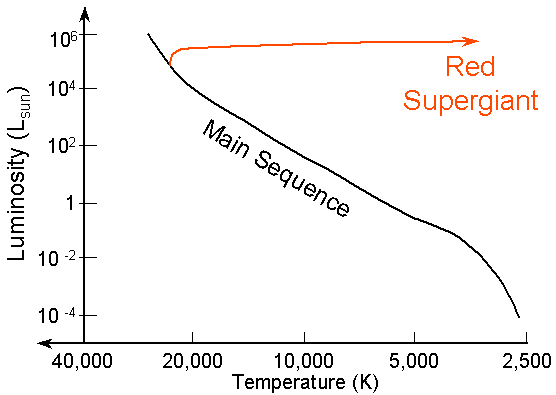
(Graphic by R. Pogge)
Takes about 1 Myr to cross the H-R diagram.
Helium Flash
Core Temperature reaches 170 Million K
Ignites Helium burning to C & O:
- Rapid Phase: ~ 1 Myr
- He burning in the core
- H burning in a shell
- Starts building a C-O core
Star becomes a Blue Supergiant.
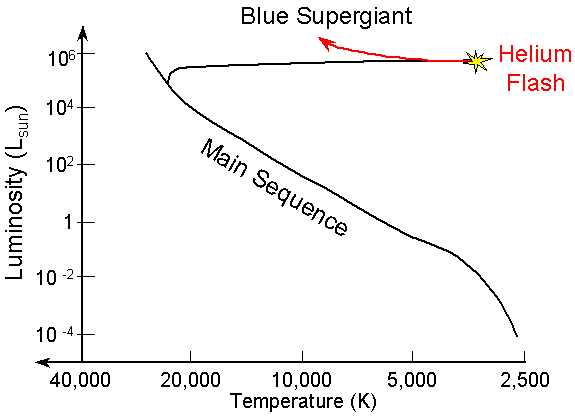
(Graphic by R. Pogge)
He Core Exhaustion
When He runs out in the core:
- Inert C-O core collapses & heats up
- H & He burning into shells
- Becomes a Red Supergiant again
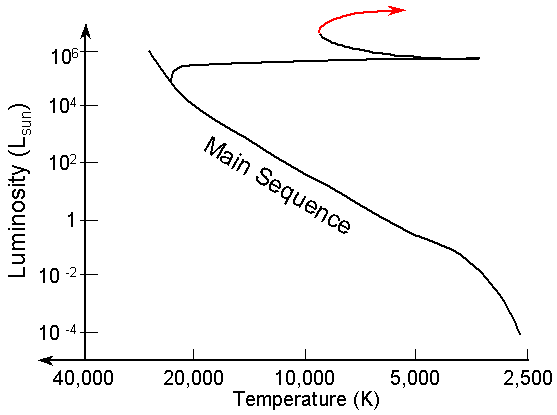
(Graphic by R. Pogge)
C-O Core collapses until:
- Tcore > 600 Million K
- density > 150,000 g/cc
- Ignites Carbon Burning in the Core.
Carbon Burning:
Nuclear reaction network: 12C+12C
fuses to:
- 24Mg
- 20Ne + 4He
- 16O + 2 4He
Build up an inert O-Ne-Mg core
Very inefficient:
- Makes many neutrinos
- Lasts only ~1000 years before C runs out.
Core of the Star at the end of the Carbon Burning Phase:
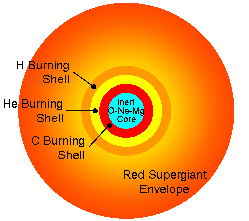
(Graphic by R. Pogge)
Intermediate Mass Stars
Stars with 4 < M < 8 Msun
After 1000 years:
- Inert O-Ne-Mg core contracts & heats up
- C, He, & H burning shells
Thermal pulses destabilize the envelope:
- Eject the envelope in a massive stellar wind.
- Leave O-Ne-Mg white dwarf core behind.
High Mass Stars: M > 8 Msun
At the onset of Carbon Burning:
- Evolution is so fast that the envelope can no longer respond.
- Should see little outward sign of the inward turmoil to come.
Exception: Strong stellar winds can erode the envelope,
changing the outward appearance of the star.
[For example, the massive star Eta Carina has immense stellar
winds. Hubble reveals a furiously expanding pair of dust and
gas clouds billowing off this star.
See this page
at STScI for more details & pictures.]
Neon Burning
O-Ne-Mg core contracts & heats up until:
- Tcore ~ 1.5 Billion K
- density ~ 107 g/cc
Ignite Neon burning:
- reaction network makes O, Mg, & others
- Huge neutrino losses: > L* !
- Builds a heavy O-Mg core
Lasts for a few years before Ne runs out.
Oxygen Burning
Ne runs out, core contracts & heats up until:
- Tcore ~ 2.1 Billion K
- density ~ few x 107 g/cc
Ignite Oxygen burning:
- reaction network making Si, S, P, & others
- Huge neutrino losses: > 100,000 L* !
- Builds a heavy Si core.
Lasts for ~ 1 year before O runs out.
Silicon Burning
O runs out, Si core contracts & heats up until:
- Tcore ~ 3.5 Billion K
- density ~ 108 g/cc
Ignite Silicon burning:
- Si melts into a sea of He, p, & n
- Fuses with rest into Nickel (Ni) & Iron (Fe)
- Builds a heavy Ni/Fe core.
Lasts for about 1 day...
Core of a massive star at the end of Silicon Burning:
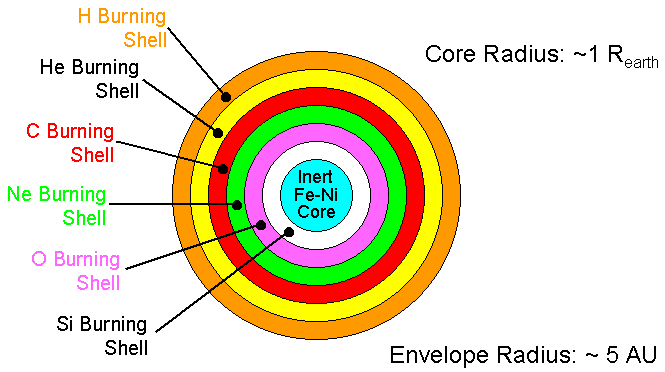
(Graphic by R. Pogge)
The Nuclear Impasse
Fusion of light elements is the release of nuclear binding
energy.
Iron (Fe) is the most tightly bound nucleus:
- Fusion of nuclei lighter than Fe releases energy.
- Fusion of nuclei heavier than Fe absorbs energy.
Once an Fe core forms, there are no new fusion reactions left
for the star to tap.
End of the Road
At the end of the Silicon Burning Day:
- Build up an inert Fe core
- Onion Skin of nested nuclear burning shells
Finally, the Fe core exceeds 1.2-2 Msun:
- Fe core begins to contract & heat up.
- Collapse is final & catastrophic
Summary:
Stars with 4 < Mass < 8 Msun
- Burn through Carbon
- Blow off their envelope
- Core becomes an O-Ne-Mg White Dwarf
Stars with Mass > 8 Msun
- Burn Carbon, Neon, Oxygen & Silicon
- Build up a heavy Iron Core & burning shells.
- Final stage occurs when the Iron core begins to collapse.
Updated/modified 2014, Todd Thompson
Copyright Richard W. Pogge,
All Rights Reserved.






